Innovation Audit and Analysis of Barclays PLC's Capabilities
VerifiedAdded on 2020/12/30
|12
|3909
|76
Report
AI Summary
This report provides an in-depth innovation audit of Barclays PLC, a leading financial service provider. It begins with an executive summary outlining the key findings, followed by an introduction that establishes the report's purpose: to analyze Barclays' innovation capabilities. The report delves into the organization's history, using PESTLE analysis to identify macro-environmental factors influencing innovation. Porter's Five Forces model assesses the industry's competitive landscape, and SWOT analysis reveals the bank's strengths, weaknesses, opportunities, and threats, particularly highlighting the potential of "Facial recognition Authentication technology." Furthermore, an industry analysis examines the trends and opportunities within the banking sector. The report concludes with a summary of Barclays' capabilities and recommendations for future innovation strategies, offering a comprehensive overview of the bank's innovation journey.

Managing Innovation in
Business
Business
Paraphrase This Document
Need a fresh take? Get an instant paraphrase of this document with our AI Paraphraser
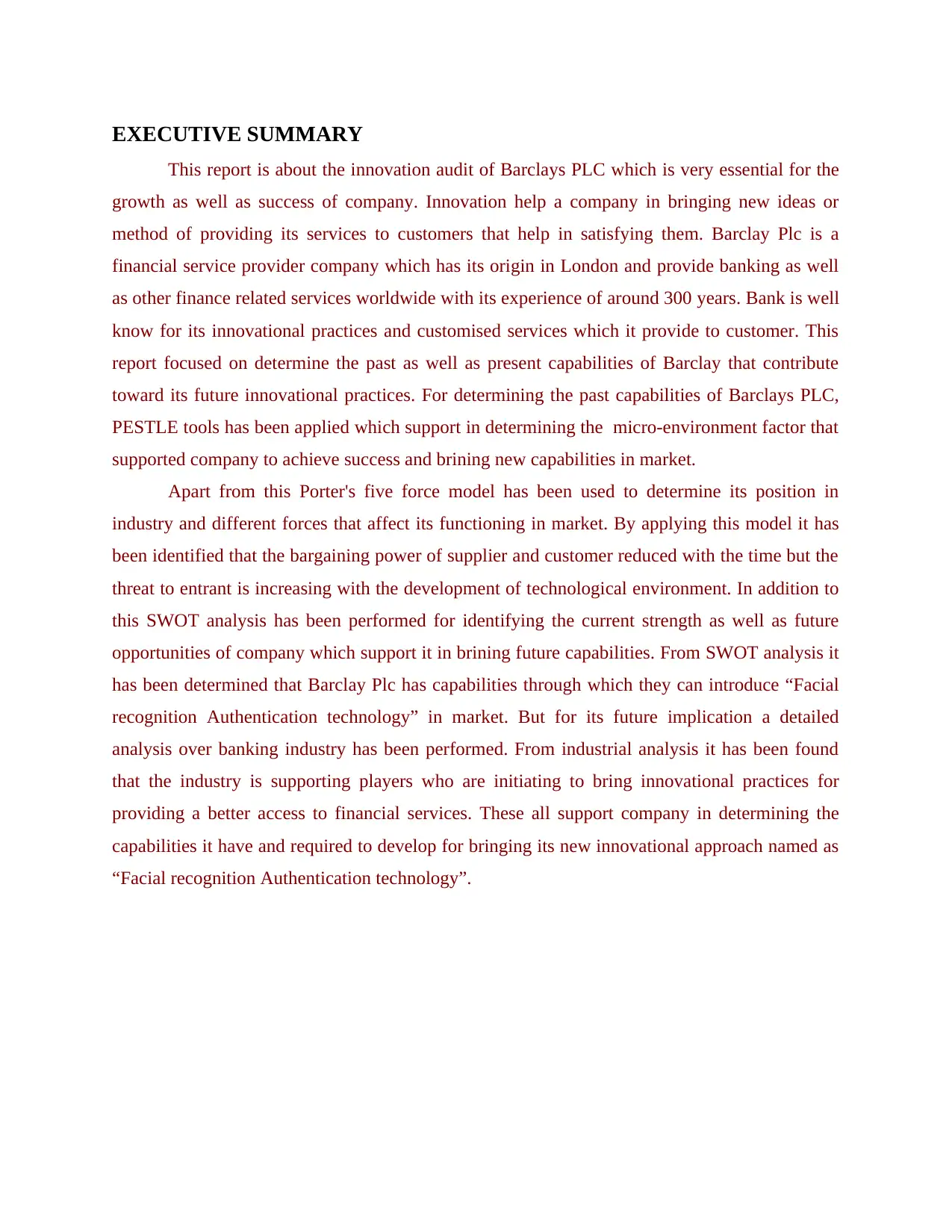
EXECUTIVE SUMMARY
This report is about the innovation audit of Barclays PLC which is very essential for the
growth as well as success of company. Innovation help a company in bringing new ideas or
method of providing its services to customers that help in satisfying them. Barclay Plc is a
financial service provider company which has its origin in London and provide banking as well
as other finance related services worldwide with its experience of around 300 years. Bank is well
know for its innovational practices and customised services which it provide to customer. This
report focused on determine the past as well as present capabilities of Barclay that contribute
toward its future innovational practices. For determining the past capabilities of Barclays PLC,
PESTLE tools has been applied which support in determining the micro-environment factor that
supported company to achieve success and brining new capabilities in market.
Apart from this Porter's five force model has been used to determine its position in
industry and different forces that affect its functioning in market. By applying this model it has
been identified that the bargaining power of supplier and customer reduced with the time but the
threat to entrant is increasing with the development of technological environment. In addition to
this SWOT analysis has been performed for identifying the current strength as well as future
opportunities of company which support it in brining future capabilities. From SWOT analysis it
has been determined that Barclay Plc has capabilities through which they can introduce “Facial
recognition Authentication technology” in market. But for its future implication a detailed
analysis over banking industry has been performed. From industrial analysis it has been found
that the industry is supporting players who are initiating to bring innovational practices for
providing a better access to financial services. These all support company in determining the
capabilities it have and required to develop for bringing its new innovational approach named as
“Facial recognition Authentication technology”.
This report is about the innovation audit of Barclays PLC which is very essential for the
growth as well as success of company. Innovation help a company in bringing new ideas or
method of providing its services to customers that help in satisfying them. Barclay Plc is a
financial service provider company which has its origin in London and provide banking as well
as other finance related services worldwide with its experience of around 300 years. Bank is well
know for its innovational practices and customised services which it provide to customer. This
report focused on determine the past as well as present capabilities of Barclay that contribute
toward its future innovational practices. For determining the past capabilities of Barclays PLC,
PESTLE tools has been applied which support in determining the micro-environment factor that
supported company to achieve success and brining new capabilities in market.
Apart from this Porter's five force model has been used to determine its position in
industry and different forces that affect its functioning in market. By applying this model it has
been identified that the bargaining power of supplier and customer reduced with the time but the
threat to entrant is increasing with the development of technological environment. In addition to
this SWOT analysis has been performed for identifying the current strength as well as future
opportunities of company which support it in brining future capabilities. From SWOT analysis it
has been determined that Barclay Plc has capabilities through which they can introduce “Facial
recognition Authentication technology” in market. But for its future implication a detailed
analysis over banking industry has been performed. From industrial analysis it has been found
that the industry is supporting players who are initiating to bring innovational practices for
providing a better access to financial services. These all support company in determining the
capabilities it have and required to develop for bringing its new innovational approach named as
“Facial recognition Authentication technology”.
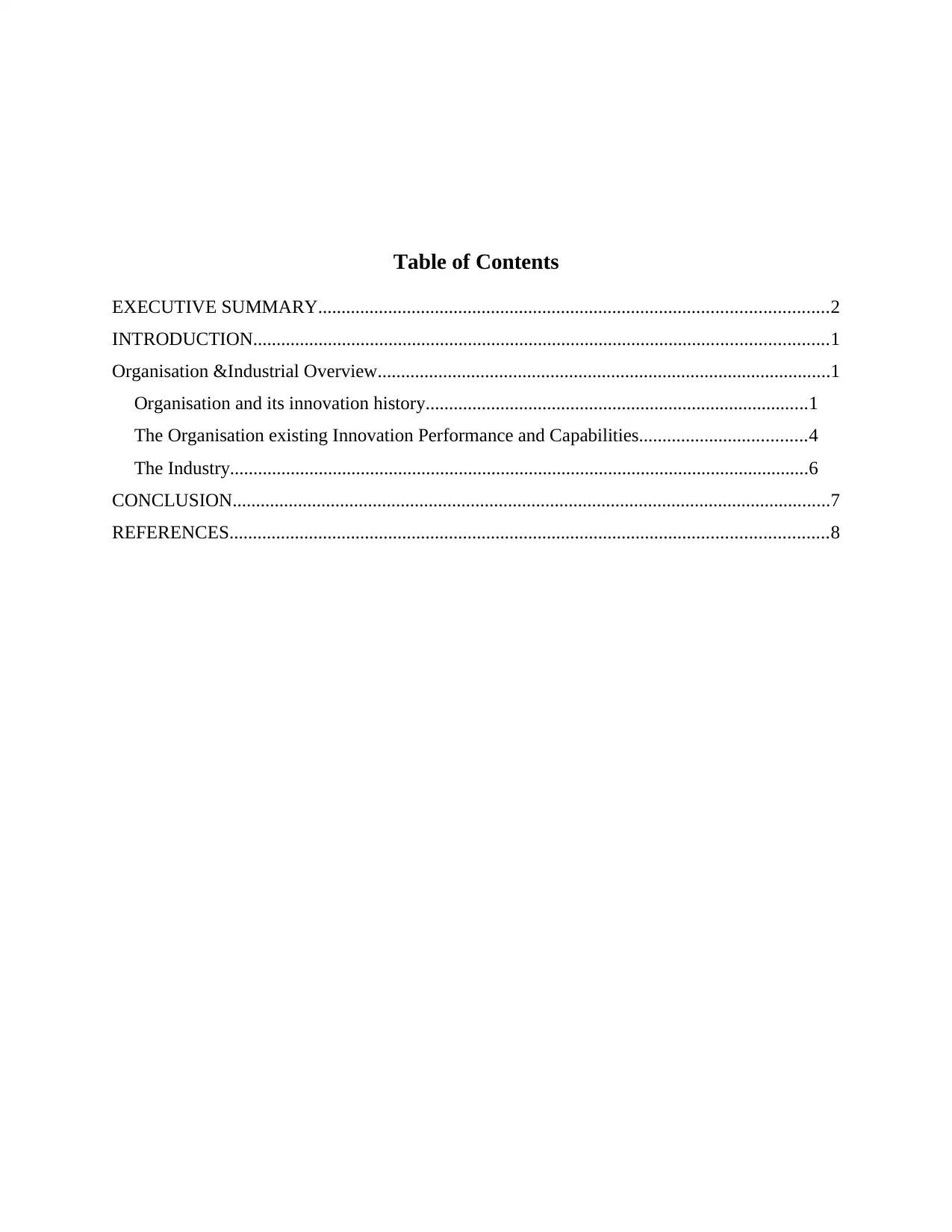
Table of Contents
EXECUTIVE SUMMARY.............................................................................................................2
INTRODUCTION...........................................................................................................................1
Organisation &Industrial Overview.................................................................................................1
Organisation and its innovation history..................................................................................1
The Organisation existing Innovation Performance and Capabilities....................................4
The Industry............................................................................................................................6
CONCLUSION................................................................................................................................7
REFERENCES................................................................................................................................8
EXECUTIVE SUMMARY.............................................................................................................2
INTRODUCTION...........................................................................................................................1
Organisation &Industrial Overview.................................................................................................1
Organisation and its innovation history..................................................................................1
The Organisation existing Innovation Performance and Capabilities....................................4
The Industry............................................................................................................................6
CONCLUSION................................................................................................................................7
REFERENCES................................................................................................................................8
⊘ This is a preview!⊘
Do you want full access?
Subscribe today to unlock all pages.

Trusted by 1+ million students worldwide
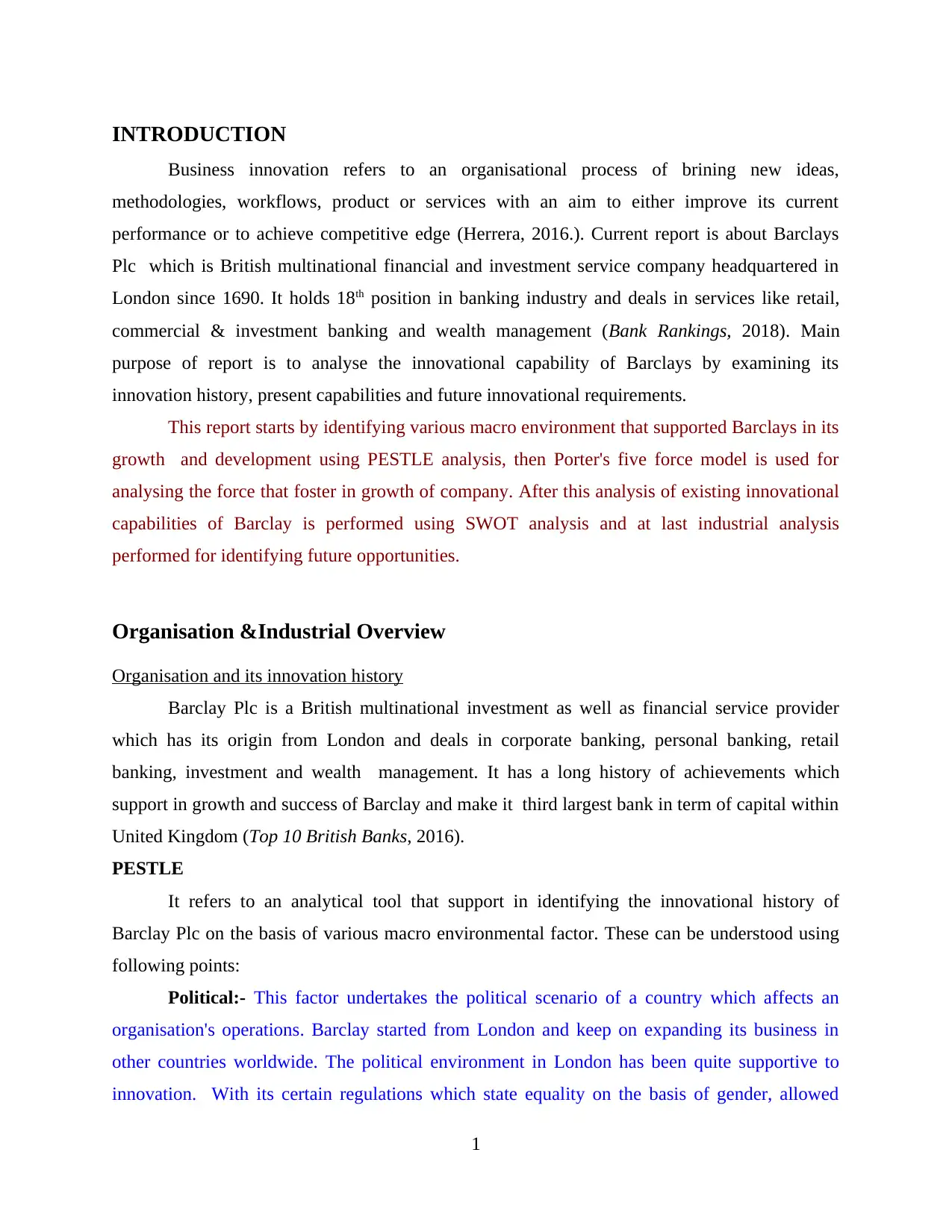
INTRODUCTION
Business innovation refers to an organisational process of brining new ideas,
methodologies, workflows, product or services with an aim to either improve its current
performance or to achieve competitive edge (Herrera, 2016.). Current report is about Barclays
Plc which is British multinational financial and investment service company headquartered in
London since 1690. It holds 18th position in banking industry and deals in services like retail,
commercial & investment banking and wealth management (Bank Rankings, 2018). Main
purpose of report is to analyse the innovational capability of Barclays by examining its
innovation history, present capabilities and future innovational requirements.
This report starts by identifying various macro environment that supported Barclays in its
growth and development using PESTLE analysis, then Porter's five force model is used for
analysing the force that foster in growth of company. After this analysis of existing innovational
capabilities of Barclay is performed using SWOT analysis and at last industrial analysis
performed for identifying future opportunities.
Organisation &Industrial Overview
Organisation and its innovation history
Barclay Plc is a British multinational investment as well as financial service provider
which has its origin from London and deals in corporate banking, personal banking, retail
banking, investment and wealth management. It has a long history of achievements which
support in growth and success of Barclay and make it third largest bank in term of capital within
United Kingdom (Top 10 British Banks, 2016).
PESTLE
It refers to an analytical tool that support in identifying the innovational history of
Barclay Plc on the basis of various macro environmental factor. These can be understood using
following points:
Political:- This factor undertakes the political scenario of a country which affects an
organisation's operations. Barclay started from London and keep on expanding its business in
other countries worldwide. The political environment in London has been quite supportive to
innovation. With its certain regulations which state equality on the basis of gender, allowed
1
Business innovation refers to an organisational process of brining new ideas,
methodologies, workflows, product or services with an aim to either improve its current
performance or to achieve competitive edge (Herrera, 2016.). Current report is about Barclays
Plc which is British multinational financial and investment service company headquartered in
London since 1690. It holds 18th position in banking industry and deals in services like retail,
commercial & investment banking and wealth management (Bank Rankings, 2018). Main
purpose of report is to analyse the innovational capability of Barclays by examining its
innovation history, present capabilities and future innovational requirements.
This report starts by identifying various macro environment that supported Barclays in its
growth and development using PESTLE analysis, then Porter's five force model is used for
analysing the force that foster in growth of company. After this analysis of existing innovational
capabilities of Barclay is performed using SWOT analysis and at last industrial analysis
performed for identifying future opportunities.
Organisation &Industrial Overview
Organisation and its innovation history
Barclay Plc is a British multinational investment as well as financial service provider
which has its origin from London and deals in corporate banking, personal banking, retail
banking, investment and wealth management. It has a long history of achievements which
support in growth and success of Barclay and make it third largest bank in term of capital within
United Kingdom (Top 10 British Banks, 2016).
PESTLE
It refers to an analytical tool that support in identifying the innovational history of
Barclay Plc on the basis of various macro environmental factor. These can be understood using
following points:
Political:- This factor undertakes the political scenario of a country which affects an
organisation's operations. Barclay started from London and keep on expanding its business in
other countries worldwide. The political environment in London has been quite supportive to
innovation. With its certain regulations which state equality on the basis of gender, allowed
1
Paraphrase This Document
Need a fresh take? Get an instant paraphrase of this document with our AI Paraphraser
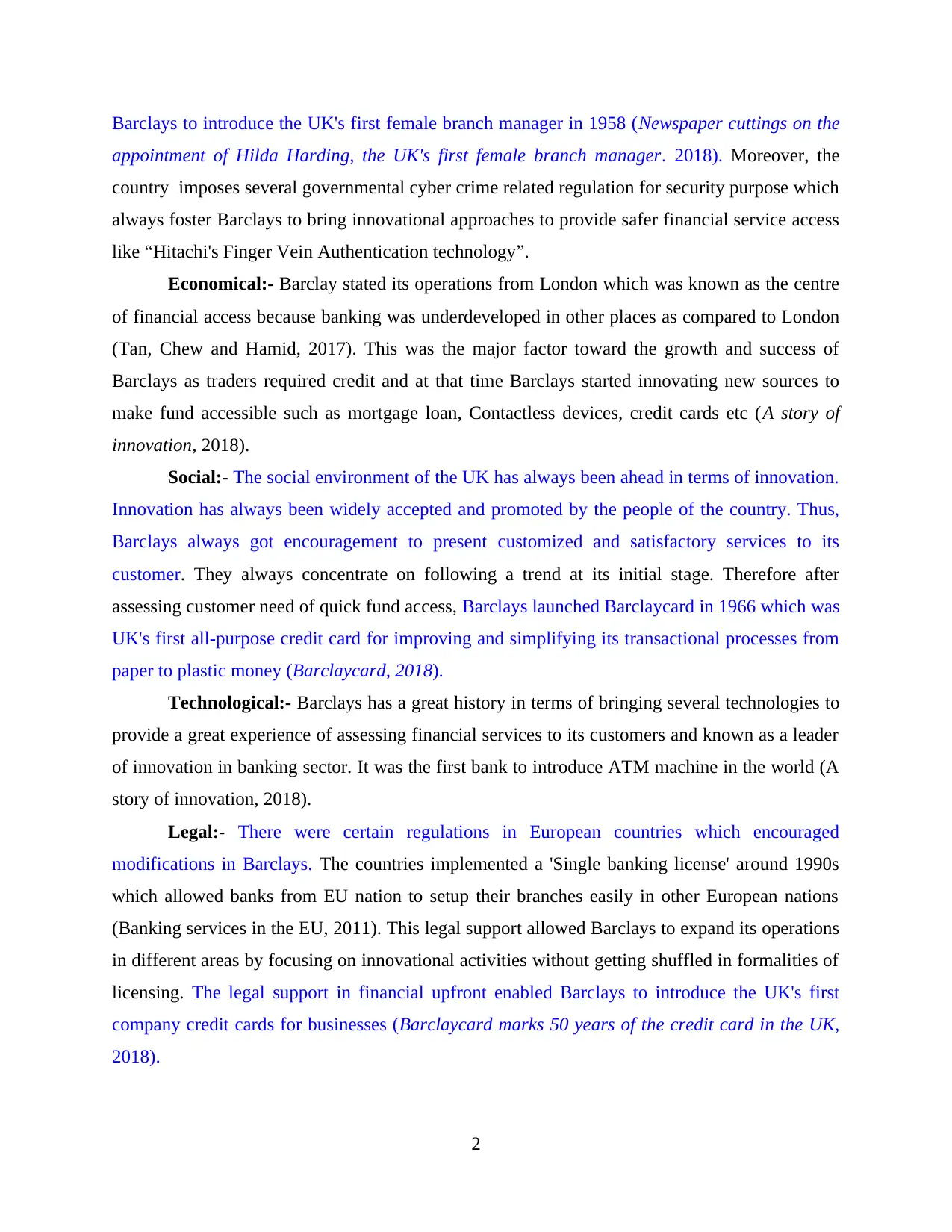
Barclays to introduce the UK's first female branch manager in 1958 (Newspaper cuttings on the
appointment of Hilda Harding, the UK's first female branch manager. 2018). Moreover, the
country imposes several governmental cyber crime related regulation for security purpose which
always foster Barclays to bring innovational approaches to provide safer financial service access
like “Hitachi's Finger Vein Authentication technology”.
Economical:- Barclay stated its operations from London which was known as the centre
of financial access because banking was underdeveloped in other places as compared to London
(Tan, Chew and Hamid, 2017). This was the major factor toward the growth and success of
Barclays as traders required credit and at that time Barclays started innovating new sources to
make fund accessible such as mortgage loan, Contactless devices, credit cards etc (A story of
innovation, 2018).
Social:- The social environment of the UK has always been ahead in terms of innovation.
Innovation has always been widely accepted and promoted by the people of the country. Thus,
Barclays always got encouragement to present customized and satisfactory services to its
customer. They always concentrate on following a trend at its initial stage. Therefore after
assessing customer need of quick fund access, Barclays launched Barclaycard in 1966 which was
UK's first all-purpose credit card for improving and simplifying its transactional processes from
paper to plastic money (Barclaycard, 2018).
Technological:- Barclays has a great history in terms of bringing several technologies to
provide a great experience of assessing financial services to its customers and known as a leader
of innovation in banking sector. It was the first bank to introduce ATM machine in the world (A
story of innovation, 2018).
Legal:- There were certain regulations in European countries which encouraged
modifications in Barclays. The countries implemented a 'Single banking license' around 1990s
which allowed banks from EU nation to setup their branches easily in other European nations
(Banking services in the EU, 2011). This legal support allowed Barclays to expand its operations
in different areas by focusing on innovational activities without getting shuffled in formalities of
licensing. The legal support in financial upfront enabled Barclays to introduce the UK's first
company credit cards for businesses (Barclaycard marks 50 years of the credit card in the UK,
2018).
2
appointment of Hilda Harding, the UK's first female branch manager. 2018). Moreover, the
country imposes several governmental cyber crime related regulation for security purpose which
always foster Barclays to bring innovational approaches to provide safer financial service access
like “Hitachi's Finger Vein Authentication technology”.
Economical:- Barclay stated its operations from London which was known as the centre
of financial access because banking was underdeveloped in other places as compared to London
(Tan, Chew and Hamid, 2017). This was the major factor toward the growth and success of
Barclays as traders required credit and at that time Barclays started innovating new sources to
make fund accessible such as mortgage loan, Contactless devices, credit cards etc (A story of
innovation, 2018).
Social:- The social environment of the UK has always been ahead in terms of innovation.
Innovation has always been widely accepted and promoted by the people of the country. Thus,
Barclays always got encouragement to present customized and satisfactory services to its
customer. They always concentrate on following a trend at its initial stage. Therefore after
assessing customer need of quick fund access, Barclays launched Barclaycard in 1966 which was
UK's first all-purpose credit card for improving and simplifying its transactional processes from
paper to plastic money (Barclaycard, 2018).
Technological:- Barclays has a great history in terms of bringing several technologies to
provide a great experience of assessing financial services to its customers and known as a leader
of innovation in banking sector. It was the first bank to introduce ATM machine in the world (A
story of innovation, 2018).
Legal:- There were certain regulations in European countries which encouraged
modifications in Barclays. The countries implemented a 'Single banking license' around 1990s
which allowed banks from EU nation to setup their branches easily in other European nations
(Banking services in the EU, 2011). This legal support allowed Barclays to expand its operations
in different areas by focusing on innovational activities without getting shuffled in formalities of
licensing. The legal support in financial upfront enabled Barclays to introduce the UK's first
company credit cards for businesses (Barclaycard marks 50 years of the credit card in the UK,
2018).
2
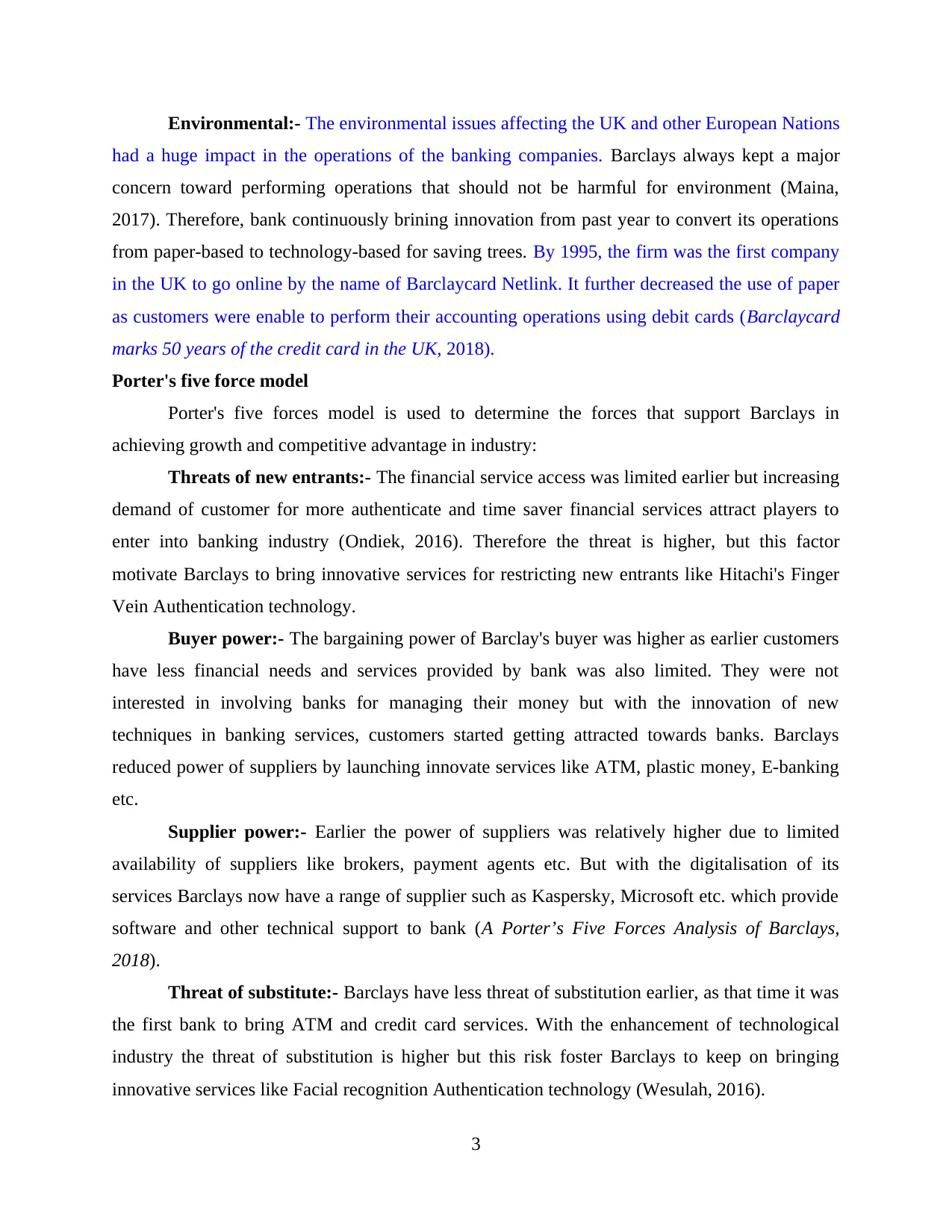
Environmental:- The environmental issues affecting the UK and other European Nations
had a huge impact in the operations of the banking companies. Barclays always kept a major
concern toward performing operations that should not be harmful for environment (Maina,
2017). Therefore, bank continuously brining innovation from past year to convert its operations
from paper-based to technology-based for saving trees. By 1995, the firm was the first company
in the UK to go online by the name of Barclaycard Netlink. It further decreased the use of paper
as customers were enable to perform their accounting operations using debit cards (Barclaycard
marks 50 years of the credit card in the UK, 2018).
Porter's five force model
Porter's five forces model is used to determine the forces that support Barclays in
achieving growth and competitive advantage in industry:
Threats of new entrants:- The financial service access was limited earlier but increasing
demand of customer for more authenticate and time saver financial services attract players to
enter into banking industry (Ondiek, 2016). Therefore the threat is higher, but this factor
motivate Barclays to bring innovative services for restricting new entrants like Hitachi's Finger
Vein Authentication technology.
Buyer power:- The bargaining power of Barclay's buyer was higher as earlier customers
have less financial needs and services provided by bank was also limited. They were not
interested in involving banks for managing their money but with the innovation of new
techniques in banking services, customers started getting attracted towards banks. Barclays
reduced power of suppliers by launching innovate services like ATM, plastic money, E-banking
etc.
Supplier power:- Earlier the power of suppliers was relatively higher due to limited
availability of suppliers like brokers, payment agents etc. But with the digitalisation of its
services Barclays now have a range of supplier such as Kaspersky, Microsoft etc. which provide
software and other technical support to bank (A Porter’s Five Forces Analysis of Barclays,
2018).
Threat of substitute:- Barclays have less threat of substitution earlier, as that time it was
the first bank to bring ATM and credit card services. With the enhancement of technological
industry the threat of substitution is higher but this risk foster Barclays to keep on bringing
innovative services like Facial recognition Authentication technology (Wesulah, 2016).
3
had a huge impact in the operations of the banking companies. Barclays always kept a major
concern toward performing operations that should not be harmful for environment (Maina,
2017). Therefore, bank continuously brining innovation from past year to convert its operations
from paper-based to technology-based for saving trees. By 1995, the firm was the first company
in the UK to go online by the name of Barclaycard Netlink. It further decreased the use of paper
as customers were enable to perform their accounting operations using debit cards (Barclaycard
marks 50 years of the credit card in the UK, 2018).
Porter's five force model
Porter's five forces model is used to determine the forces that support Barclays in
achieving growth and competitive advantage in industry:
Threats of new entrants:- The financial service access was limited earlier but increasing
demand of customer for more authenticate and time saver financial services attract players to
enter into banking industry (Ondiek, 2016). Therefore the threat is higher, but this factor
motivate Barclays to bring innovative services for restricting new entrants like Hitachi's Finger
Vein Authentication technology.
Buyer power:- The bargaining power of Barclay's buyer was higher as earlier customers
have less financial needs and services provided by bank was also limited. They were not
interested in involving banks for managing their money but with the innovation of new
techniques in banking services, customers started getting attracted towards banks. Barclays
reduced power of suppliers by launching innovate services like ATM, plastic money, E-banking
etc.
Supplier power:- Earlier the power of suppliers was relatively higher due to limited
availability of suppliers like brokers, payment agents etc. But with the digitalisation of its
services Barclays now have a range of supplier such as Kaspersky, Microsoft etc. which provide
software and other technical support to bank (A Porter’s Five Forces Analysis of Barclays,
2018).
Threat of substitute:- Barclays have less threat of substitution earlier, as that time it was
the first bank to bring ATM and credit card services. With the enhancement of technological
industry the threat of substitution is higher but this risk foster Barclays to keep on bringing
innovative services like Facial recognition Authentication technology (Wesulah, 2016).
3
⊘ This is a preview!⊘
Do you want full access?
Subscribe today to unlock all pages.

Trusted by 1+ million students worldwide
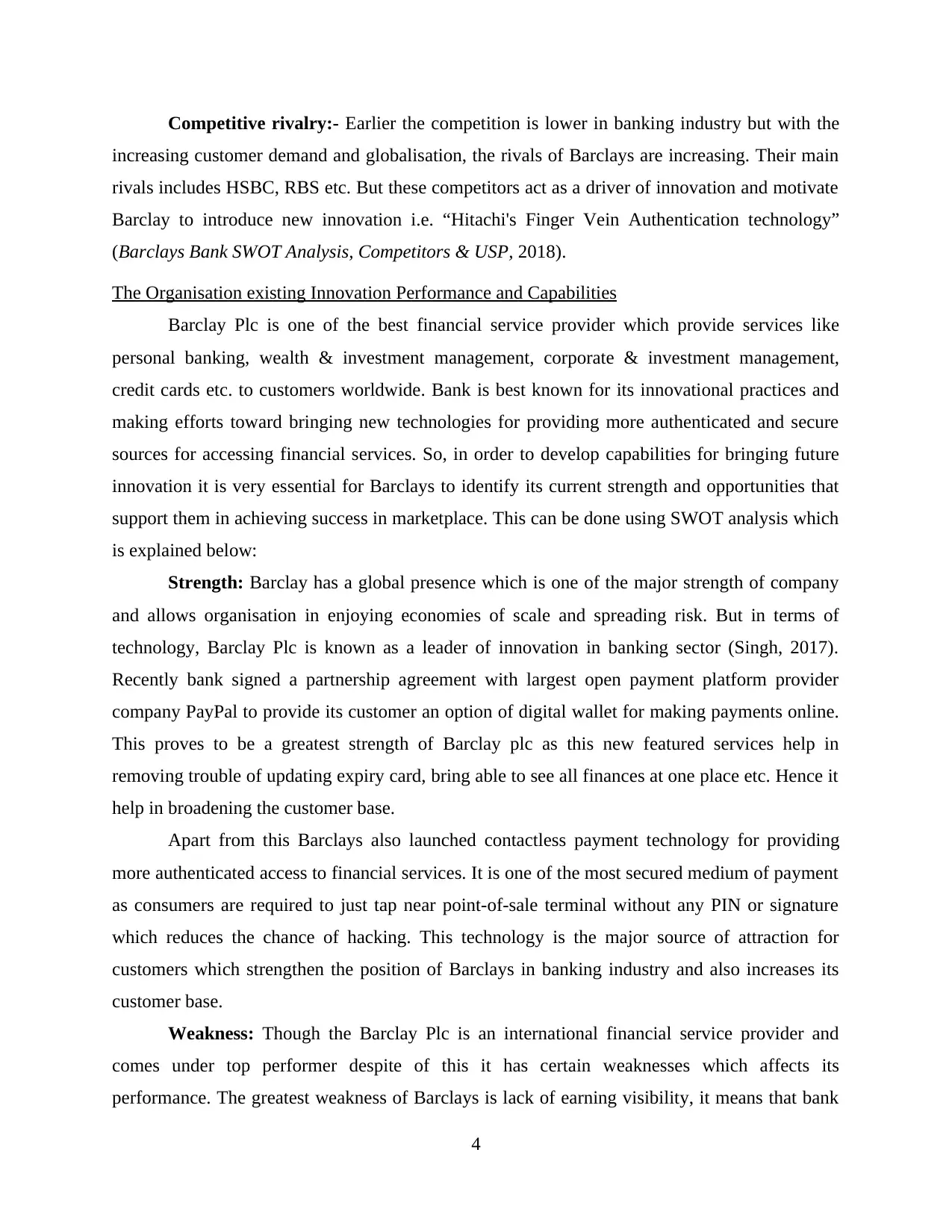
Competitive rivalry:- Earlier the competition is lower in banking industry but with the
increasing customer demand and globalisation, the rivals of Barclays are increasing. Their main
rivals includes HSBC, RBS etc. But these competitors act as a driver of innovation and motivate
Barclay to introduce new innovation i.e. “Hitachi's Finger Vein Authentication technology”
(Barclays Bank SWOT Analysis, Competitors & USP, 2018).
The Organisation existing Innovation Performance and Capabilities
Barclay Plc is one of the best financial service provider which provide services like
personal banking, wealth & investment management, corporate & investment management,
credit cards etc. to customers worldwide. Bank is best known for its innovational practices and
making efforts toward bringing new technologies for providing more authenticated and secure
sources for accessing financial services. So, in order to develop capabilities for bringing future
innovation it is very essential for Barclays to identify its current strength and opportunities that
support them in achieving success in marketplace. This can be done using SWOT analysis which
is explained below:
Strength: Barclay has a global presence which is one of the major strength of company
and allows organisation in enjoying economies of scale and spreading risk. But in terms of
technology, Barclay Plc is known as a leader of innovation in banking sector (Singh, 2017).
Recently bank signed a partnership agreement with largest open payment platform provider
company PayPal to provide its customer an option of digital wallet for making payments online.
This proves to be a greatest strength of Barclay plc as this new featured services help in
removing trouble of updating expiry card, bring able to see all finances at one place etc. Hence it
help in broadening the customer base.
Apart from this Barclays also launched contactless payment technology for providing
more authenticated access to financial services. It is one of the most secured medium of payment
as consumers are required to just tap near point-of-sale terminal without any PIN or signature
which reduces the chance of hacking. This technology is the major source of attraction for
customers which strengthen the position of Barclays in banking industry and also increases its
customer base.
Weakness: Though the Barclay Plc is an international financial service provider and
comes under top performer despite of this it has certain weaknesses which affects its
performance. The greatest weakness of Barclays is lack of earning visibility, it means that bank
4
increasing customer demand and globalisation, the rivals of Barclays are increasing. Their main
rivals includes HSBC, RBS etc. But these competitors act as a driver of innovation and motivate
Barclay to introduce new innovation i.e. “Hitachi's Finger Vein Authentication technology”
(Barclays Bank SWOT Analysis, Competitors & USP, 2018).
The Organisation existing Innovation Performance and Capabilities
Barclay Plc is one of the best financial service provider which provide services like
personal banking, wealth & investment management, corporate & investment management,
credit cards etc. to customers worldwide. Bank is best known for its innovational practices and
making efforts toward bringing new technologies for providing more authenticated and secure
sources for accessing financial services. So, in order to develop capabilities for bringing future
innovation it is very essential for Barclays to identify its current strength and opportunities that
support them in achieving success in marketplace. This can be done using SWOT analysis which
is explained below:
Strength: Barclay has a global presence which is one of the major strength of company
and allows organisation in enjoying economies of scale and spreading risk. But in terms of
technology, Barclay Plc is known as a leader of innovation in banking sector (Singh, 2017).
Recently bank signed a partnership agreement with largest open payment platform provider
company PayPal to provide its customer an option of digital wallet for making payments online.
This proves to be a greatest strength of Barclay plc as this new featured services help in
removing trouble of updating expiry card, bring able to see all finances at one place etc. Hence it
help in broadening the customer base.
Apart from this Barclays also launched contactless payment technology for providing
more authenticated access to financial services. It is one of the most secured medium of payment
as consumers are required to just tap near point-of-sale terminal without any PIN or signature
which reduces the chance of hacking. This technology is the major source of attraction for
customers which strengthen the position of Barclays in banking industry and also increases its
customer base.
Weakness: Though the Barclay Plc is an international financial service provider and
comes under top performer despite of this it has certain weaknesses which affects its
performance. The greatest weakness of Barclays is lack of earning visibility, it means that bank
4
Paraphrase This Document
Need a fresh take? Get an instant paraphrase of this document with our AI Paraphraser
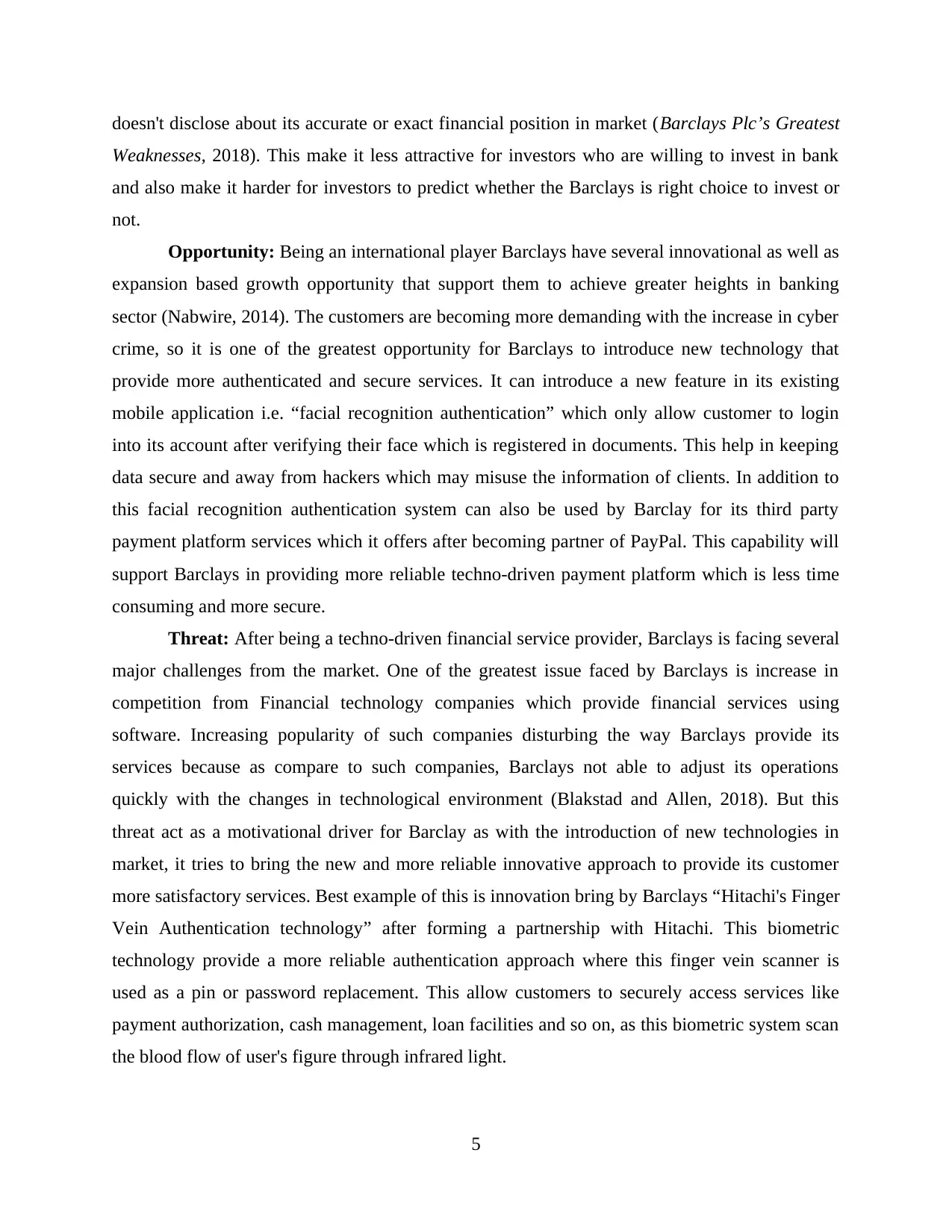
doesn't disclose about its accurate or exact financial position in market (Barclays Plc’s Greatest
Weaknesses, 2018). This make it less attractive for investors who are willing to invest in bank
and also make it harder for investors to predict whether the Barclays is right choice to invest or
not.
Opportunity: Being an international player Barclays have several innovational as well as
expansion based growth opportunity that support them to achieve greater heights in banking
sector (Nabwire, 2014). The customers are becoming more demanding with the increase in cyber
crime, so it is one of the greatest opportunity for Barclays to introduce new technology that
provide more authenticated and secure services. It can introduce a new feature in its existing
mobile application i.e. “facial recognition authentication” which only allow customer to login
into its account after verifying their face which is registered in documents. This help in keeping
data secure and away from hackers which may misuse the information of clients. In addition to
this facial recognition authentication system can also be used by Barclay for its third party
payment platform services which it offers after becoming partner of PayPal. This capability will
support Barclays in providing more reliable techno-driven payment platform which is less time
consuming and more secure.
Threat: After being a techno-driven financial service provider, Barclays is facing several
major challenges from the market. One of the greatest issue faced by Barclays is increase in
competition from Financial technology companies which provide financial services using
software. Increasing popularity of such companies disturbing the way Barclays provide its
services because as compare to such companies, Barclays not able to adjust its operations
quickly with the changes in technological environment (Blakstad and Allen, 2018). But this
threat act as a motivational driver for Barclay as with the introduction of new technologies in
market, it tries to bring the new and more reliable innovative approach to provide its customer
more satisfactory services. Best example of this is innovation bring by Barclays “Hitachi's Finger
Vein Authentication technology” after forming a partnership with Hitachi. This biometric
technology provide a more reliable authentication approach where this finger vein scanner is
used as a pin or password replacement. This allow customers to securely access services like
payment authorization, cash management, loan facilities and so on, as this biometric system scan
the blood flow of user's figure through infrared light.
5
Weaknesses, 2018). This make it less attractive for investors who are willing to invest in bank
and also make it harder for investors to predict whether the Barclays is right choice to invest or
not.
Opportunity: Being an international player Barclays have several innovational as well as
expansion based growth opportunity that support them to achieve greater heights in banking
sector (Nabwire, 2014). The customers are becoming more demanding with the increase in cyber
crime, so it is one of the greatest opportunity for Barclays to introduce new technology that
provide more authenticated and secure services. It can introduce a new feature in its existing
mobile application i.e. “facial recognition authentication” which only allow customer to login
into its account after verifying their face which is registered in documents. This help in keeping
data secure and away from hackers which may misuse the information of clients. In addition to
this facial recognition authentication system can also be used by Barclay for its third party
payment platform services which it offers after becoming partner of PayPal. This capability will
support Barclays in providing more reliable techno-driven payment platform which is less time
consuming and more secure.
Threat: After being a techno-driven financial service provider, Barclays is facing several
major challenges from the market. One of the greatest issue faced by Barclays is increase in
competition from Financial technology companies which provide financial services using
software. Increasing popularity of such companies disturbing the way Barclays provide its
services because as compare to such companies, Barclays not able to adjust its operations
quickly with the changes in technological environment (Blakstad and Allen, 2018). But this
threat act as a motivational driver for Barclay as with the introduction of new technologies in
market, it tries to bring the new and more reliable innovative approach to provide its customer
more satisfactory services. Best example of this is innovation bring by Barclays “Hitachi's Finger
Vein Authentication technology” after forming a partnership with Hitachi. This biometric
technology provide a more reliable authentication approach where this finger vein scanner is
used as a pin or password replacement. This allow customers to securely access services like
payment authorization, cash management, loan facilities and so on, as this biometric system scan
the blood flow of user's figure through infrared light.
5
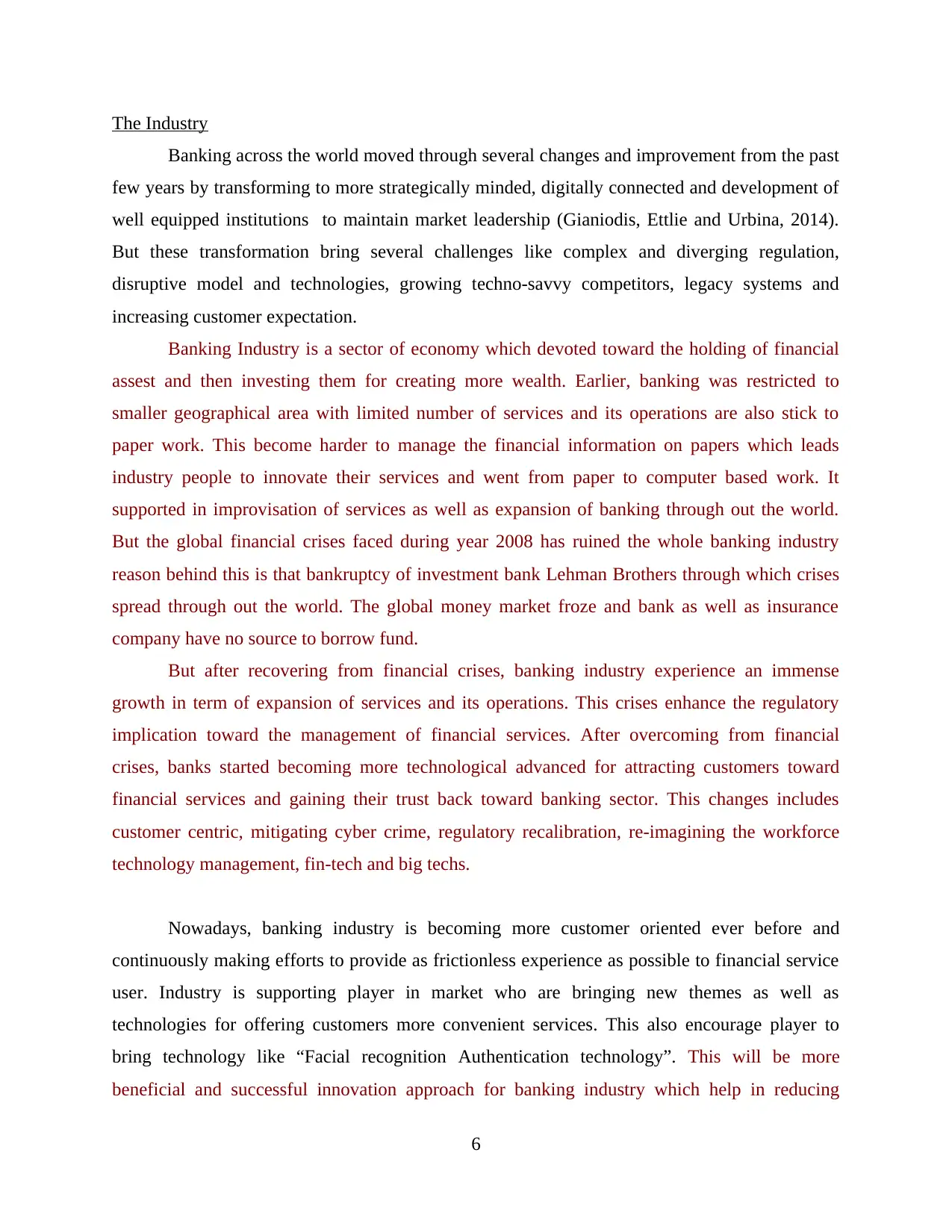
The Industry
Banking across the world moved through several changes and improvement from the past
few years by transforming to more strategically minded, digitally connected and development of
well equipped institutions to maintain market leadership (Gianiodis, Ettlie and Urbina, 2014).
But these transformation bring several challenges like complex and diverging regulation,
disruptive model and technologies, growing techno-savvy competitors, legacy systems and
increasing customer expectation.
Banking Industry is a sector of economy which devoted toward the holding of financial
assest and then investing them for creating more wealth. Earlier, banking was restricted to
smaller geographical area with limited number of services and its operations are also stick to
paper work. This become harder to manage the financial information on papers which leads
industry people to innovate their services and went from paper to computer based work. It
supported in improvisation of services as well as expansion of banking through out the world.
But the global financial crises faced during year 2008 has ruined the whole banking industry
reason behind this is that bankruptcy of investment bank Lehman Brothers through which crises
spread through out the world. The global money market froze and bank as well as insurance
company have no source to borrow fund.
But after recovering from financial crises, banking industry experience an immense
growth in term of expansion of services and its operations. This crises enhance the regulatory
implication toward the management of financial services. After overcoming from financial
crises, banks started becoming more technological advanced for attracting customers toward
financial services and gaining their trust back toward banking sector. This changes includes
customer centric, mitigating cyber crime, regulatory recalibration, re-imagining the workforce
technology management, fin-tech and big techs.
Nowadays, banking industry is becoming more customer oriented ever before and
continuously making efforts to provide as frictionless experience as possible to financial service
user. Industry is supporting player in market who are bringing new themes as well as
technologies for offering customers more convenient services. This also encourage player to
bring technology like “Facial recognition Authentication technology”. This will be more
beneficial and successful innovation approach for banking industry which help in reducing
6
Banking across the world moved through several changes and improvement from the past
few years by transforming to more strategically minded, digitally connected and development of
well equipped institutions to maintain market leadership (Gianiodis, Ettlie and Urbina, 2014).
But these transformation bring several challenges like complex and diverging regulation,
disruptive model and technologies, growing techno-savvy competitors, legacy systems and
increasing customer expectation.
Banking Industry is a sector of economy which devoted toward the holding of financial
assest and then investing them for creating more wealth. Earlier, banking was restricted to
smaller geographical area with limited number of services and its operations are also stick to
paper work. This become harder to manage the financial information on papers which leads
industry people to innovate their services and went from paper to computer based work. It
supported in improvisation of services as well as expansion of banking through out the world.
But the global financial crises faced during year 2008 has ruined the whole banking industry
reason behind this is that bankruptcy of investment bank Lehman Brothers through which crises
spread through out the world. The global money market froze and bank as well as insurance
company have no source to borrow fund.
But after recovering from financial crises, banking industry experience an immense
growth in term of expansion of services and its operations. This crises enhance the regulatory
implication toward the management of financial services. After overcoming from financial
crises, banks started becoming more technological advanced for attracting customers toward
financial services and gaining their trust back toward banking sector. This changes includes
customer centric, mitigating cyber crime, regulatory recalibration, re-imagining the workforce
technology management, fin-tech and big techs.
Nowadays, banking industry is becoming more customer oriented ever before and
continuously making efforts to provide as frictionless experience as possible to financial service
user. Industry is supporting player in market who are bringing new themes as well as
technologies for offering customers more convenient services. This also encourage player to
bring technology like “Facial recognition Authentication technology”. This will be more
beneficial and successful innovation approach for banking industry which help in reducing
6
⊘ This is a preview!⊘
Do you want full access?
Subscribe today to unlock all pages.

Trusted by 1+ million students worldwide
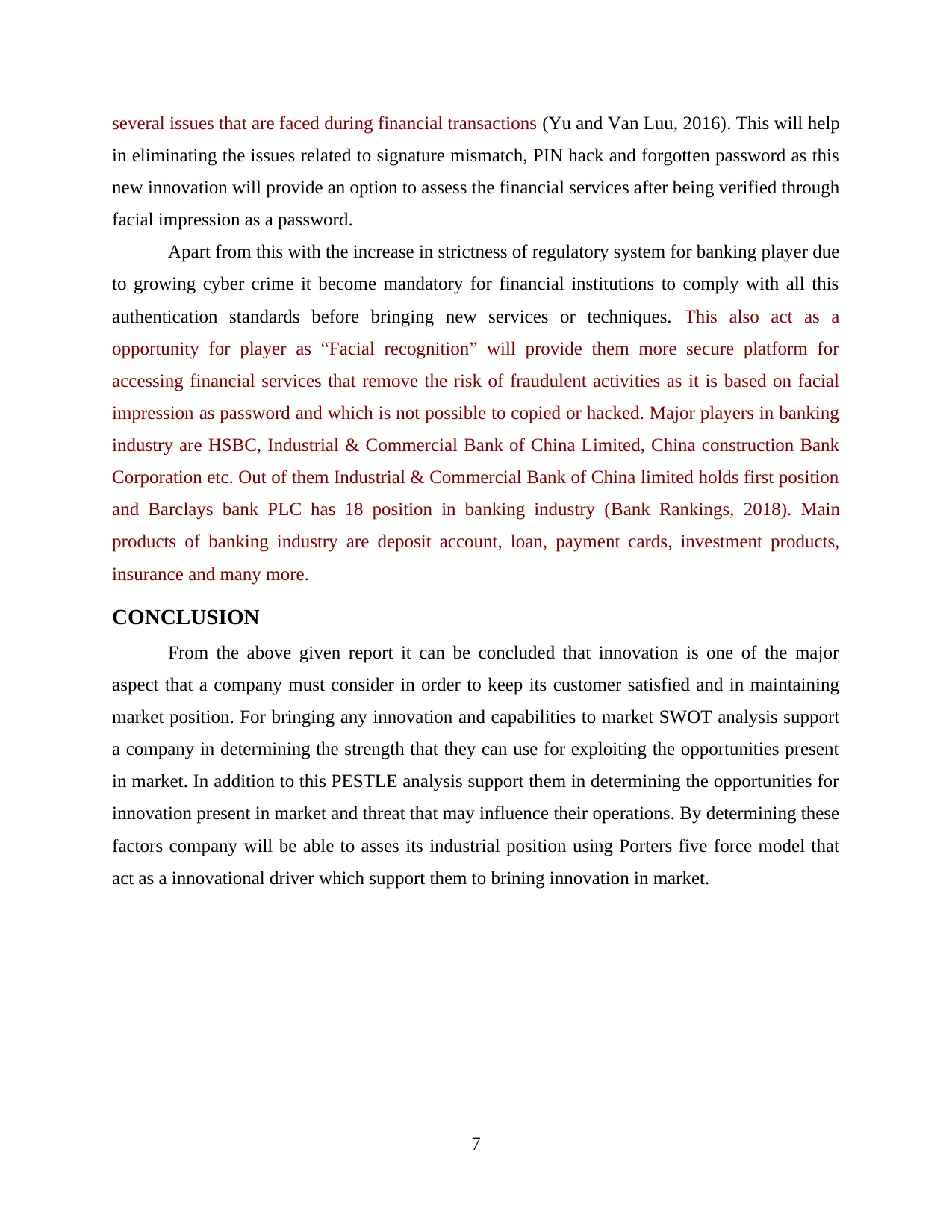
several issues that are faced during financial transactions (Yu and Van Luu, 2016). This will help
in eliminating the issues related to signature mismatch, PIN hack and forgotten password as this
new innovation will provide an option to assess the financial services after being verified through
facial impression as a password.
Apart from this with the increase in strictness of regulatory system for banking player due
to growing cyber crime it become mandatory for financial institutions to comply with all this
authentication standards before bringing new services or techniques. This also act as a
opportunity for player as “Facial recognition” will provide them more secure platform for
accessing financial services that remove the risk of fraudulent activities as it is based on facial
impression as password and which is not possible to copied or hacked. Major players in banking
industry are HSBC, Industrial & Commercial Bank of China Limited, China construction Bank
Corporation etc. Out of them Industrial & Commercial Bank of China limited holds first position
and Barclays bank PLC has 18 position in banking industry (Bank Rankings, 2018). Main
products of banking industry are deposit account, loan, payment cards, investment products,
insurance and many more.
CONCLUSION
From the above given report it can be concluded that innovation is one of the major
aspect that a company must consider in order to keep its customer satisfied and in maintaining
market position. For bringing any innovation and capabilities to market SWOT analysis support
a company in determining the strength that they can use for exploiting the opportunities present
in market. In addition to this PESTLE analysis support them in determining the opportunities for
innovation present in market and threat that may influence their operations. By determining these
factors company will be able to asses its industrial position using Porters five force model that
act as a innovational driver which support them to brining innovation in market.
7
in eliminating the issues related to signature mismatch, PIN hack and forgotten password as this
new innovation will provide an option to assess the financial services after being verified through
facial impression as a password.
Apart from this with the increase in strictness of regulatory system for banking player due
to growing cyber crime it become mandatory for financial institutions to comply with all this
authentication standards before bringing new services or techniques. This also act as a
opportunity for player as “Facial recognition” will provide them more secure platform for
accessing financial services that remove the risk of fraudulent activities as it is based on facial
impression as password and which is not possible to copied or hacked. Major players in banking
industry are HSBC, Industrial & Commercial Bank of China Limited, China construction Bank
Corporation etc. Out of them Industrial & Commercial Bank of China limited holds first position
and Barclays bank PLC has 18 position in banking industry (Bank Rankings, 2018). Main
products of banking industry are deposit account, loan, payment cards, investment products,
insurance and many more.
CONCLUSION
From the above given report it can be concluded that innovation is one of the major
aspect that a company must consider in order to keep its customer satisfied and in maintaining
market position. For bringing any innovation and capabilities to market SWOT analysis support
a company in determining the strength that they can use for exploiting the opportunities present
in market. In addition to this PESTLE analysis support them in determining the opportunities for
innovation present in market and threat that may influence their operations. By determining these
factors company will be able to asses its industrial position using Porters five force model that
act as a innovational driver which support them to brining innovation in market.
7
Paraphrase This Document
Need a fresh take? Get an instant paraphrase of this document with our AI Paraphraser
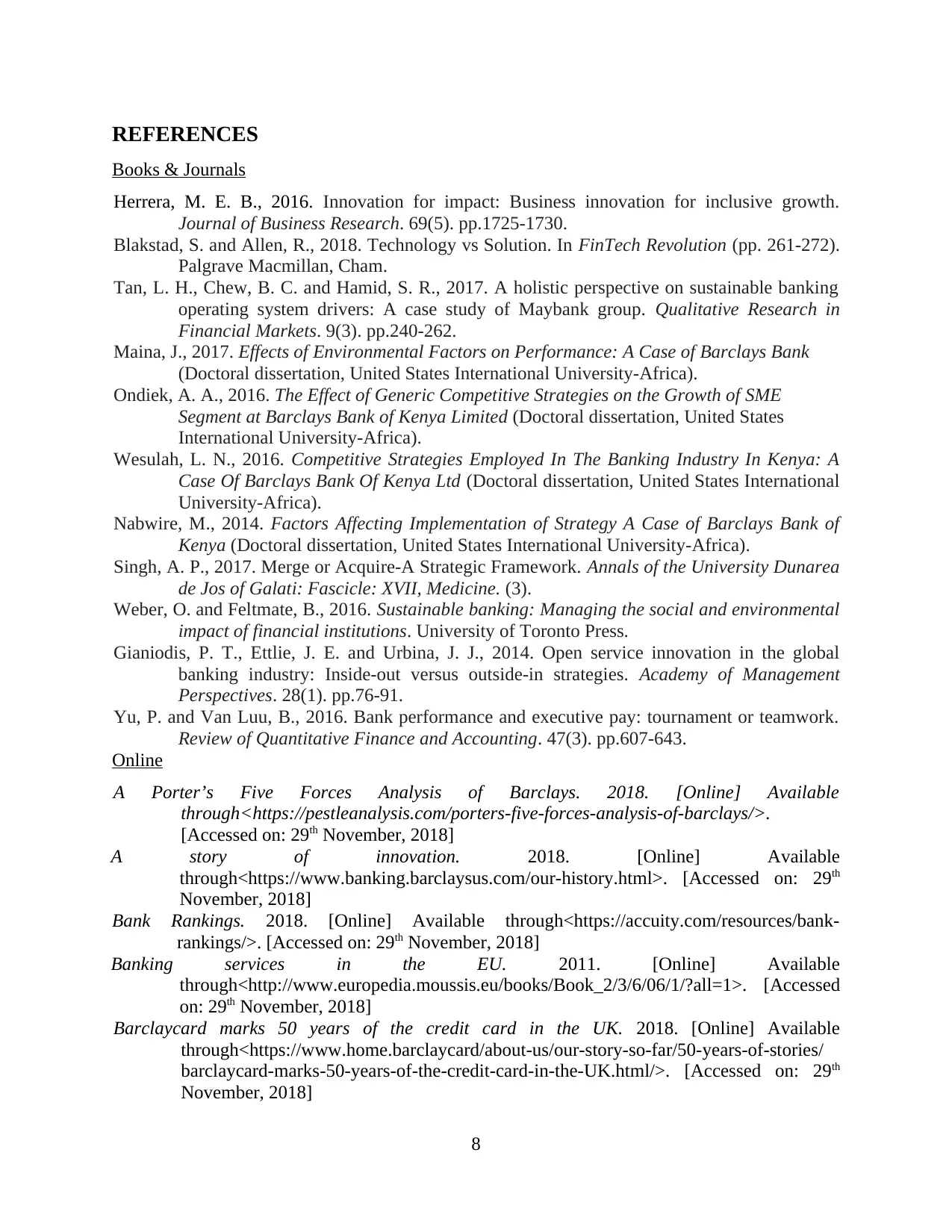
REFERENCES
Books & Journals
Herrera, M. E. B., 2016. Innovation for impact: Business innovation for inclusive growth.
Journal of Business Research. 69(5). pp.1725-1730.
Blakstad, S. and Allen, R., 2018. Technology vs Solution. In FinTech Revolution (pp. 261-272).
Palgrave Macmillan, Cham.
Tan, L. H., Chew, B. C. and Hamid, S. R., 2017. A holistic perspective on sustainable banking
operating system drivers: A case study of Maybank group. Qualitative Research in
Financial Markets. 9(3). pp.240-262.
Maina, J., 2017. Effects of Environmental Factors on Performance: A Case of Barclays Bank
(Doctoral dissertation, United States International University-Africa).
Ondiek, A. A., 2016. The Effect of Generic Competitive Strategies on the Growth of SME
Segment at Barclays Bank of Kenya Limited (Doctoral dissertation, United States
International University-Africa).
Wesulah, L. N., 2016. Competitive Strategies Employed In The Banking Industry In Kenya: A
Case Of Barclays Bank Of Kenya Ltd (Doctoral dissertation, United States International
University-Africa).
Nabwire, M., 2014. Factors Affecting Implementation of Strategy A Case of Barclays Bank of
Kenya (Doctoral dissertation, United States International University-Africa).
Singh, A. P., 2017. Merge or Acquire-A Strategic Framework. Annals of the University Dunarea
de Jos of Galati: Fascicle: XVII, Medicine. (3).
Weber, O. and Feltmate, B., 2016. Sustainable banking: Managing the social and environmental
impact of financial institutions. University of Toronto Press.
Gianiodis, P. T., Ettlie, J. E. and Urbina, J. J., 2014. Open service innovation in the global
banking industry: Inside-out versus outside-in strategies. Academy of Management
Perspectives. 28(1). pp.76-91.
Yu, P. and Van Luu, B., 2016. Bank performance and executive pay: tournament or teamwork.
Review of Quantitative Finance and Accounting. 47(3). pp.607-643.
Online
A Porter’s Five Forces Analysis of Barclays. 2018. [Online] Available
through<https://pestleanalysis.com/porters-five-forces-analysis-of-barclays/>.
[Accessed on: 29th November, 2018]
A story of innovation. 2018. [Online] Available
through<https://www.banking.barclaysus.com/our-history.html>. [Accessed on: 29th
November, 2018]
Bank Rankings. 2018. [Online] Available through<https://accuity.com/resources/bank-
rankings/>. [Accessed on: 29th November, 2018]
Banking services in the EU. 2011. [Online] Available
through<http://www.europedia.moussis.eu/books/Book_2/3/6/06/1/?all=1>. [Accessed
on: 29th November, 2018]
Barclaycard marks 50 years of the credit card in the UK. 2018. [Online] Available
through<https://www.home.barclaycard/about-us/our-story-so-far/50-years-of-stories/
barclaycard-marks-50-years-of-the-credit-card-in-the-UK.html/>. [Accessed on: 29th
November, 2018]
8
Books & Journals
Herrera, M. E. B., 2016. Innovation for impact: Business innovation for inclusive growth.
Journal of Business Research. 69(5). pp.1725-1730.
Blakstad, S. and Allen, R., 2018. Technology vs Solution. In FinTech Revolution (pp. 261-272).
Palgrave Macmillan, Cham.
Tan, L. H., Chew, B. C. and Hamid, S. R., 2017. A holistic perspective on sustainable banking
operating system drivers: A case study of Maybank group. Qualitative Research in
Financial Markets. 9(3). pp.240-262.
Maina, J., 2017. Effects of Environmental Factors on Performance: A Case of Barclays Bank
(Doctoral dissertation, United States International University-Africa).
Ondiek, A. A., 2016. The Effect of Generic Competitive Strategies on the Growth of SME
Segment at Barclays Bank of Kenya Limited (Doctoral dissertation, United States
International University-Africa).
Wesulah, L. N., 2016. Competitive Strategies Employed In The Banking Industry In Kenya: A
Case Of Barclays Bank Of Kenya Ltd (Doctoral dissertation, United States International
University-Africa).
Nabwire, M., 2014. Factors Affecting Implementation of Strategy A Case of Barclays Bank of
Kenya (Doctoral dissertation, United States International University-Africa).
Singh, A. P., 2017. Merge or Acquire-A Strategic Framework. Annals of the University Dunarea
de Jos of Galati: Fascicle: XVII, Medicine. (3).
Weber, O. and Feltmate, B., 2016. Sustainable banking: Managing the social and environmental
impact of financial institutions. University of Toronto Press.
Gianiodis, P. T., Ettlie, J. E. and Urbina, J. J., 2014. Open service innovation in the global
banking industry: Inside-out versus outside-in strategies. Academy of Management
Perspectives. 28(1). pp.76-91.
Yu, P. and Van Luu, B., 2016. Bank performance and executive pay: tournament or teamwork.
Review of Quantitative Finance and Accounting. 47(3). pp.607-643.
Online
A Porter’s Five Forces Analysis of Barclays. 2018. [Online] Available
through<https://pestleanalysis.com/porters-five-forces-analysis-of-barclays/>.
[Accessed on: 29th November, 2018]
A story of innovation. 2018. [Online] Available
through<https://www.banking.barclaysus.com/our-history.html>. [Accessed on: 29th
November, 2018]
Bank Rankings. 2018. [Online] Available through<https://accuity.com/resources/bank-
rankings/>. [Accessed on: 29th November, 2018]
Banking services in the EU. 2011. [Online] Available
through<http://www.europedia.moussis.eu/books/Book_2/3/6/06/1/?all=1>. [Accessed
on: 29th November, 2018]
Barclaycard marks 50 years of the credit card in the UK. 2018. [Online] Available
through<https://www.home.barclaycard/about-us/our-story-so-far/50-years-of-stories/
barclaycard-marks-50-years-of-the-credit-card-in-the-UK.html/>. [Accessed on: 29th
November, 2018]
8
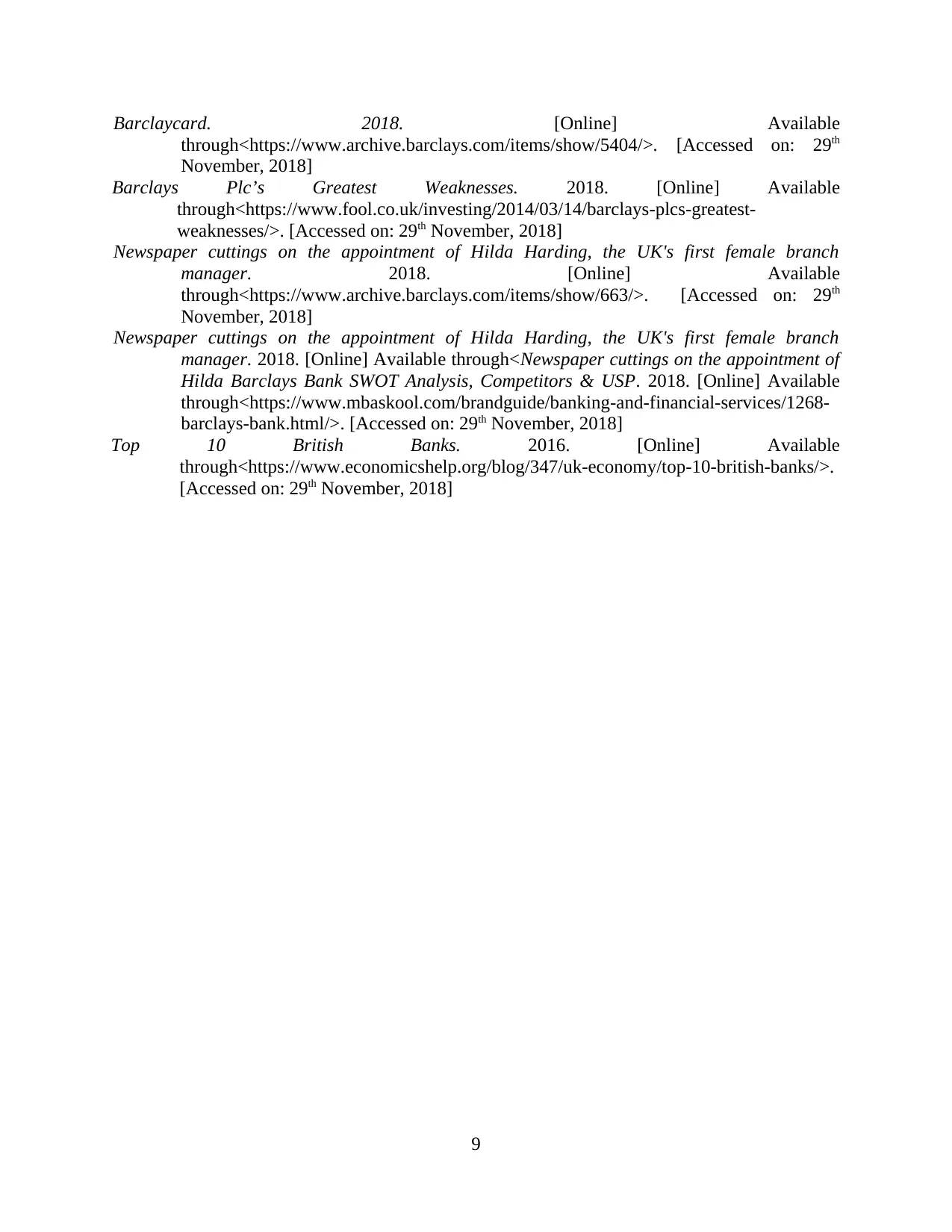
Barclaycard. 2018. [Online] Available
through<https://www.archive.barclays.com/items/show/5404/>. [Accessed on: 29th
November, 2018]
Barclays Plc’s Greatest Weaknesses. 2018. [Online] Available
through<https://www.fool.co.uk/investing/2014/03/14/barclays-plcs-greatest-
weaknesses/>. [Accessed on: 29th November, 2018]
Newspaper cuttings on the appointment of Hilda Harding, the UK's first female branch
manager. 2018. [Online] Available
through<https://www.archive.barclays.com/items/show/663/>. [Accessed on: 29th
November, 2018]
Newspaper cuttings on the appointment of Hilda Harding, the UK's first female branch
manager. 2018. [Online] Available through<Newspaper cuttings on the appointment of
Hilda Barclays Bank SWOT Analysis, Competitors & USP. 2018. [Online] Available
through<https://www.mbaskool.com/brandguide/banking-and-financial-services/1268-
barclays-bank.html/>. [Accessed on: 29th November, 2018]
Top 10 British Banks. 2016. [Online] Available
through<https://www.economicshelp.org/blog/347/uk-economy/top-10-british-banks/>.
[Accessed on: 29th November, 2018]
9
through<https://www.archive.barclays.com/items/show/5404/>. [Accessed on: 29th
November, 2018]
Barclays Plc’s Greatest Weaknesses. 2018. [Online] Available
through<https://www.fool.co.uk/investing/2014/03/14/barclays-plcs-greatest-
weaknesses/>. [Accessed on: 29th November, 2018]
Newspaper cuttings on the appointment of Hilda Harding, the UK's first female branch
manager. 2018. [Online] Available
through<https://www.archive.barclays.com/items/show/663/>. [Accessed on: 29th
November, 2018]
Newspaper cuttings on the appointment of Hilda Harding, the UK's first female branch
manager. 2018. [Online] Available through<Newspaper cuttings on the appointment of
Hilda Barclays Bank SWOT Analysis, Competitors & USP. 2018. [Online] Available
through<https://www.mbaskool.com/brandguide/banking-and-financial-services/1268-
barclays-bank.html/>. [Accessed on: 29th November, 2018]
Top 10 British Banks. 2016. [Online] Available
through<https://www.economicshelp.org/blog/347/uk-economy/top-10-british-banks/>.
[Accessed on: 29th November, 2018]
9
⊘ This is a preview!⊘
Do you want full access?
Subscribe today to unlock all pages.

Trusted by 1+ million students worldwide
1 out of 12
Related Documents
Your All-in-One AI-Powered Toolkit for Academic Success.
+13062052269
info@desklib.com
Available 24*7 on WhatsApp / Email
![[object Object]](/_next/static/media/star-bottom.7253800d.svg)
Unlock your academic potential
Copyright © 2020–2025 A2Z Services. All Rights Reserved. Developed and managed by ZUCOL.




